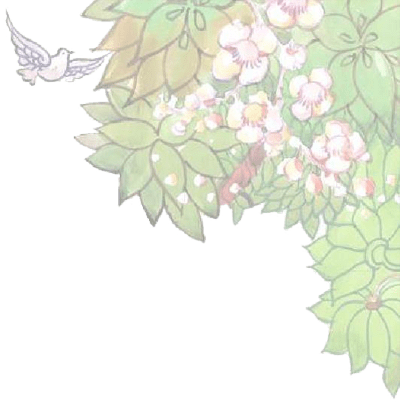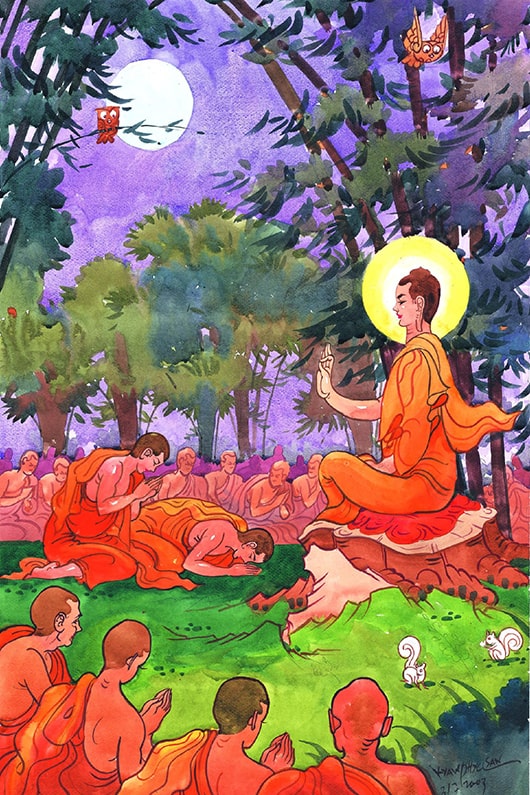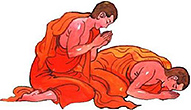28話 二大弟子 ・・・・ サーリプッタとモッガラーナ

第3部 法輪を転じる~伝道布教へ
第2章 サンガ(僧団)
28話 二大弟子 ・・・・ サーリプッタとモッガラーナ

菩薩がブッダとなる前、ラージャガハに近いウパティッサ村で、ルーパサーリーという名のバラモンの女性で村長の妻が、男の子を産んだ。なおウパティッサ村はナーラカ村という名でも知られている。村長の息子なのでウパティッサと名づけられた。その赤ちゃんの母親はルーパサーリーなので、サーリプッタとも呼ばれた。これもラージャガハに近いコーリタ村で、ウパティッサが生まれたのと同じ日に、村長の息子が生まれた。その赤ちゃんも村長の息子なのでコーリタと名づけられた。母親はモッガーラーという名なので、モッガラーナとも呼ばれた。男の子たちは、ふたりともすくすく育った。いずれも裕福な家で、なに不自由なく贅沢に養育された。ふたりは幼いころから親しく、育っていくうちに親友になった。
ある日、ふたりは毎年恒例のギラッガ・サマッジャ山上祭を見物していた。芝居の出し物を見てふたりは楽しんだ。しかしながら二、三日たった後、喜劇役者の演じる芝居をもはや楽しめず、恐怖芝居も、もう怖くなくなってしまった。見るべきものが何もなくなったのである。これらすべては束の間の幸福を与えてくれるだけだ、と感じたのだ。再生と死の輪廻からの解放へみちびいてくれるものは何か、と考えていた。そのとき輪廻から解脱するために何らかの精神生活の方法を探求しよう、とふたりの意見が一致したのだ。
そのころ遍歴行者(パリッバージャカ)のサンジャヤが、弟子二百五十人とともにラージャガハに住んでいた。ウパティッサとコーリタは、サンジャヤのもとで聖なる修行をしようと合意した.短期間のうちに、ふたりは師の教義を理解して、そのありのままを知ることができた。しかしながら、それ以上、先に進めなかった。到達したことに満足できず、ふたりはサンジャヤのもとを去り、他のバラモンや行者から、より高度の知恵を探求した。ふたりはとても多くの場所を遍歴し、師から師へ次々に学んで歩いたが、それでも輪廻からの解脱へみちびいてくれる道をみつけることができなかった。それで、ふたりはそれぞれのふるさとの村へ帰り、どちらであれその道を最初にみつけたら互いに知らせよう、と申し合わせたのである。
ある朝、アッサジ尊者がラージャガハの通りに沿って托鉢していたとき、遍歴修行者のウパティッサが通りかかった。ウパティッサはアッサジ尊者の往き帰りの動き、行く手を見るのと脇を見るその視線の動き、両手を曲げ伸ばす動き、どのように眼を伏し目にするか、どのように品よく優雅に動くのか、注意深く観察した。そして、アッサジ尊者の立ち居ふるまいに深く印象づけられた。とても気品があり、気づきにみち、気配りがあり、安らぎにみちているのだ。このような行者を見たことがなかった。かれは、こう考えた。(この行者は阿羅漢に達しているか、阿羅漢に到る道を実践されているにちがいない)
ウパティッサは、もっとこの人のことを知りたくなった。しかし、いまは尋ねるのにふさわしいときではない、と考えて、アッサジ尊者の少し後ろから跡をつけて行き、ふさわしいときを待った。
アッサジ尊者が托鉢を終えたとき、ウパティッサは尊者が坐る席を用意した。尊者が食事をしたとき、持っていた水差しから水を注いだ。ひとりの門下生としての義務を果たして、親しみをこめてあいさつし、こういった。
「友よ、あなたの挙措には落ちつきがあり、あなたの顔は晴れやかで、輝いています。友よ、どなたのもとで、あなたは歩んでこられたのでしょうか? どなたが師なのですか? あなたは、誰の法(ダンマ)を信奉されているのですか?」
「友よ、わたしは世尊のもとで歩んできました。サーキャ(釈迦)族の方で、この世を捨てられ、比丘となられた方です。世尊が、わが師です。世尊の法に従い、実践しています」と、アッサジ尊者は答えた。
それからウパティッサがきいた。
「しかし、あなたの師は何をいわれているのですか? 世尊は何を教えていらっしゃるのですか?」
アッサジ尊者が答えた。
「友よ、わたしはこの法(ダンマ)や戒律について新参者に過ぎません。あなたに法(ダンマ)を詳しく教えられません。でも、その意味をかいつまんであなたにお話しましょう」
ウパティッサは、こういった。
「どうぞ尊者さま、お願いします。あなたの可能な限り、多少であっても、本質的な意味だけ、お話ください。なぜなら本質的な意味以外には、わたしには必要がありませんので」
そこでアッサジ尊者は、因果法則について世尊の教えを要約した四行の偈を朗唱したのである。
“Ye dhammā hetuppabhavā
tesaṃ hetuṃ Tathāgato āha
tesañca yo nirodho
evaṃ vādī mahāsamaṇo”
“諸法(もろもろのものごと)は因により生じる。
如来はそれらの因を語られた。
また、それらの滅も。
このように、偉大な沙門(修行者)は説かれた。”
ちょうど水面から上に顔をのぞかせて育っている一輪のハスの花が、朝の陽の光にふれて、ただちに花弁を開くように、鋭敏な頭脳で賢明なウパティッサは、偈の最初の二行を聴いて真理を完全に理解し、預流果に達したのだった。
ウパティッサは、真理を示して世尊の本質的な教えを理解させてくれたアッサジ尊者に最高の敬意を表した。それ以降、ウパティッサは、アッサジ尊者がどこに住んでいても、必ずその場所の方向に拝礼することで、師に対して感謝の思いを表した。そしてまた、その方向には足を向けては寝ず、頭をその方向にして寝たのである。
世尊が竹林精舎に住まわれている、と知ったので、アッサジ尊者に礼拝してから、ウパティッサはかれの友コーリタのもとに行き、みつけたことを知らせた。コーリタは、ウパティッサの落ちつきのある様子をふしぎに思った。晴れやかで、輝かしい顔をしているのだ。すぐさま、かれは、ウパティッサが解脱への道をみつけたのか、ときいた。するとウパティッサは、何が起きたのか、コーリタに話して、それからアッサジ尊者から聴いた四行の偈をくりかえした。偈のすべてを聴いたあと、コーリタは預流果に達した。
竹林精舎へふたりで向かう途中、師の遍歴行者サンジャヤに会うため、最初に師のもとへ立ち寄った。そして吉報を伝え、いっしょに行って世尊に会おう、と誘った。サンジャヤは拒否した。しかしながらサンジャヤの二百五十人の弟子たちはウパティッサとコーリタに頼って生きていたので、世尊の住まわれている竹林精舎へついて行った。サンジャヤはそこにひとり残され、落ちこみ、口から熱い血を噴き出した。
世尊がサンガ(僧団)の真ん中に坐って説法していると、ふたりの友と二百五十人の遍歴行者たちがやってきた。世尊に礼拝してから、かれらは次のように申し上げた。
「尊い方よ、われらは世尊立ち会いの御前で出家し、受戒を望んでいます」
そこで世尊はかれらにこう言って戒を授けた。
「来たれ、比丘たちよ! 法は高らかに説かれた。苦の完全な滅尽のために聖なる修行をしなさい」
そして、世尊が二百五十人の比丘たちそれぞれの知能の程度や性格に合わせて、適切な説法を十分にして、ふたりの友を除いて、全員が阿羅漢に達した。
コーリタはみずからの受戒後からはモッガラーナ尊者として知られているが、カッラヴァーラプッタと呼ばれる小さな村へ行った。そこで聖なる修行を非常に熱心に実践したので、七日目には疲れを感じて坐り込み、眠気に負けてしまった。世尊は要素の分析の教え(界業処)によってかれを起こした。教えについていくことで、モッガラーナ尊者はその日のうちに阿羅漢に達することができた。
しかしながら、サーリプッタ尊者はまだ阿羅漢に達していなかった。受戒から半月後、ラージャガハに近いギッジャクータ山(鷲峰山)のスーカラカター窟に世尊とともに滞在しているあいだに、尊者は世尊の遍歴行者ディーガナカへの説法「感受摂受経(ヴェーダナー パリッガハ スッタ)」-これは「ディーガナカ(長爪)経」(中部第74)としても知られているが-を聴かれた。世尊の後ろに立って扇であおいでいる間、教えに心を集中してよく考えてみた。そしてかれの心は汚染から解放されたのである。かれは阿羅漢になった。
比丘たちの教団内で、サーリプッタ尊者は、偉大な智慧では第一人者の弟子(智慧第一(エータダッガン マハーパンニャーナン))であり、一方、モッガラーナ尊者は、偉大な神通力では第一人者の弟子(神通第一(エータダッガン イッディマンターナン))である。
※ 画像やテキストの無断使用はご遠慮ください。/ All rights reserved.

Episode 28
Sāriputta AND Moggallāna, THE TWO CHIEF BHIKKHU DISCIPLES
Before the Bodhisatta became a Buddha, in the village of Upatissa—also known as Nālaka—near Rājagaha, a brahmin lady named Rūpasārī—wife of the village chief—gave birth to a baby boy. They named their son Upatissa as he was the son of the village chief of Upatissa. The baby was also called Sāriputta, the son of Rūpasārī. In
another village named Kolita—also near Rājagaha—on the same day that Upatissa was born, there was also born a baby boy in the family of the village chief. The baby was named Kolita as he was the son of the village chief of Kolita. The baby was also called Moggallāna, the son of Moggalī, his mother. Both of the boys were well nurtured. They were brought up in luxury as they came from the well-to-do families. They grew up and became intimate friends since their childhood.
One day, they were watching an annual hill-top festival, called Giragga Samajja, in Rājagaha. They watched the shows and enjoyed themselves. However, after a few days, they were no longer amused by the comedian shows and they were no longer frightened by the horror shows. They found nothing worth seeing. They felt that all these could only give transient happiness. They were thinking of something which
would lead them to liberation from the cycle of rebirth and death (saṁsāra). Then, they agreed to search for some form of spiritual way of life in order to escape from saṁsāra.
At that time, the wandering ascetic (paribbājaka) Sañjaya was living in Rājagaha with two hundred and fifty disciples. Upatissa and Kolita agreed to lead the holy life under him. In a short period, they could understand and realise all the doctrines of their teacher. However, they could go no further than that. Unsatisfied with their
achievement, they left Sañjaya and searched for higher knowledge from other brahmins and ascetics. Although they wandered to so many places and had learnt from one teacher after another, still they could not find the way leading to liberation from saṁsāra. Then, they went back to their own villages and made an agreement that whoever would first discover the Path should inform the other.
One morning, when the Venerable Assaji was going on alms-round along the street of Rājagaha, the wanderer Upatissa came across him. He watched carefully how the Venerable Assaji moved forwards or backwards, looked ahead or aside, bent or stretched his arms, how his eyes were downcast and how he moved with grace. He was deeply impressed by the Venerable Assaji’s manner, which was so elegant, mindful, careful, and peaceful. As he had never seen such an ascetic, he thought: “This ascetic must be one who has attained Arahantship or is practising the path leading to Arahantship. Upatissa was eager to know more about him. But finding that it was not a suitable time to ask, he then tailed the Venerable Assaji from some distance behind,
waiting for the right time to ask.
When the Venerable Assaji had finished his alms-round, Upatissa prepared a seat for him. He offered some water from his jug when the Venerable Assaji had taken his meal. Having fulfilled the duties of a pupil, he exchanged pleasant greetings with him and said thus:
“Friend, your faculties are serene; your complexion is clear and bright. Friend, under whom have you gone forth? Who is your teacher? Whose Dhamma do you profess?”
“Friend, I have gone forth under the Blessed One, a son of the Sākyans, who renounced the world and became a bhikkhu. He is my teacher. I follow and practise under the Blessed One’s Dhamma,” the Venerable Assaji replied.
Then, Upatissa asked: “But, what does your teacher say? What does He teach?”
The Venerable Assaji replied: “Friend, I am only a junior in this Dhamma and Discipline. I cannot teach you the Dhamma in detail. But, I will tell you its meaning in brief.”
Upatissa said: “Please, Venerable sir, tell me much or little according to your ability. Just tell me the essential meaning, for I need no more than the essential meaning.”
Accordingly, the Venerable Assaji recited a four-line verse which summed up the Blessed One’s Teachings on the law of cause and effect:
“Ye dhammā hetuppabhavā
tesaṁ hetuṁ Tathāgato āha
tesañca yo nirodho
evaṁ vādī mahāsamaṇo”
“Everything is causally arisen.
The Tathāgata has told their cause
And also what brings their cessation.
Such is the Doctrine preached by the Great Monk.”
Just as a lotus—growing and standing out of the water surface—would immediately open their petals after being touched by the morning sunshine, even so, Upatissa—who was sharp-witted and wise—having heard the first two lines of the verse, comprehended the Truth and attained the Fruition of Sotāpatti.
Upatissa showed his highest respect towards the Venerable Assaji, who had taught him the Truth and had made him understand the essential Teachings of the Blessed One. Later on, Upatissa never failed to show his gratitude towards his teacher by paying homage to the direction wherever the Venerable Assaji lived, and he would also sleep with his head to that direction.
Knowing that the Blessed One was residing at the Veḷuvana Monastery and having paid homage to the Venerable Assaji, Upatissa went to his friend, Kolita, to inform him what he had found. Kolita wondered at Upatissa’s serene appearance, which has a clear and bright complexion.
Immediately, he asked whether Upatissa had found the path to liberation. Then, Upatissa told Kolita what had happened and repeated the four-line verse which he had heard from the Venerable Assaji. After hearing the verse in full length, Kolita attained the Fruition of Sotāpatti.
On the way to the Veḷuvana Monastery, they first stopped to see their teacher, the wandering ascetic Sañjaya, and told him the good news and invited him to join them and meet the Blessed One. Sañjaya rejected. However, the two hundred and fifty disciples of Sañjaya, whose living was much dependent on them, followed Upatissa and Kolita to the Veḷuvana Monastery, where the Blessed One was residing. Sañjaya was so much depressed finding he was alone in his precinct that hot blood
spurted from his mouth.
The Blessed One was sitting amidst the Saṁgha and delivering a discourse when the two friends and two hundred and fifty wanderers came. Having paid their obeisance to the Blessed One, they said:
“Lord, we wish to have the going forth and higher ordination in the presence of the Blessed One.”
Then, the Blessed One ordained them by saying: “Come, bhikkhus! The Dhamma is well proclaimed. Lead the holy life for the complete ending of suffering.” And when the Blessed One addressed them with an appropriate discourse, in accordance with the intellectual level and disposition of the two hundred and fifty bhikkhus, all but the two friends attained Arahantship.
After his ordination, Kolita—then known as the Venerable Moggallāna—went to a small village called Kallavāḷaputta. There, he practised the holy life so strenuously that on the seventh day he felt tired, sat down, and was overcome by drowsiness. The Blessed One roused him by giving meditation instructions on the analysis of elements (dhātu kammaṭṭhāna). By following the instructions, the Venerable Moggallāna could attain Arahantship on that very day.
However, the Venerable Sāriputta had not attained Arahantship yet. Half a month after his ordination, while staying with the Blessed One in the Sūkarakhatā Cave on the mount of Gijjhakūṭa (Vulture Peak) near Rājagaha, he heard the Blessed One’s discourse on the Vedanā Pariggaha Sutta—also known as the Dīghanakha Sutta—to the wanderer Dīghanakha. While he was standing behind the Blessed One and fanning Him, he contemplated on the instruction attentively, and his mind was
liberated from defilements. He became an Arahant.
In the Order of Bhikkhus, the Venerable Sāriputta is the foremost disciple in great wisdom (etadaggaṁ mahāpaññānaṁ), while the Venerable Moggallāna is the foremost disciple in great supernormal powers (etadaggaṁ iddhimantānaṁ).
 ※ 画像やテキストの無断使用はご遠慮ください。/ All rights reserved.
※ 画像やテキストの無断使用はご遠慮ください。/ All rights reserved.
アシン・クサラダンマ長老
1966年11月21日、インドネシア中部のジャワ州テマングン生まれ。中国系インドネシア人。テマングンは近くに3000メートル級の山々が聳え、山々に囲まれた小さな町。世界遺産のボロブドゥール寺院やディエン高原など観光地にも2,3時間で行ける比較的涼しい土地という。インドネシア・バンドゥンのパラヤンガン大学経済学部(経営学専攻)卒業後、首都ジャカルタのプラセトエイヤ・モレヤ経済ビジネス・スクールで財政学を修め、修士号を取得して卒業後、2年弱、民間企業勤務。1998年インドネシア・テーラワーダ(上座)仏教サンガで沙弥出家し、見習い僧に。詳しく見る
奥田 昭則
1949年徳島県生まれ。日本テーラワーダ仏教協会会員。東京大学仏文科卒。毎日新聞記者として奈良、広島、神戸の各支局、大阪本社の社会部、学芸部、神戸支局編集委員などを経て大阪本社編集局編集委員。1982年の1年間米国の地方紙で研修遊学。2017年ミャンマーに渡り、比丘出家。詳しく見る

※ 画像やテキストの無断使用はご遠慮ください。
All rights reserved.

